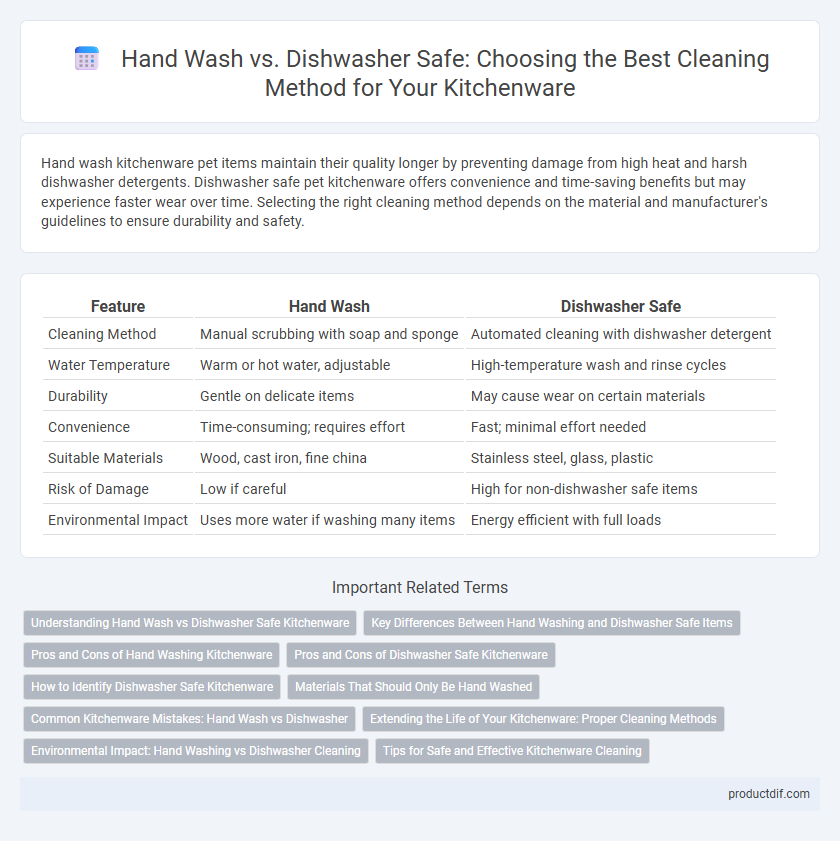Hand wash kitchenware pet items maintain their quality longer by preventing damage from high heat and harsh dishwasher detergents. Dishwasher safe pet kitchenware offers convenience and time-saving benefits but may experience faster wear over time. Selecting the right cleaning method depends on the material and manufacturer's guidelines to ensure durability and safety.
Table of Comparison
| Feature | Hand Wash | Dishwasher Safe |
|---|---|---|
| Cleaning Method | Manual scrubbing with soap and sponge | Automated cleaning with dishwasher detergent |
| Water Temperature | Warm or hot water, adjustable | High-temperature wash and rinse cycles |
| Durability | Gentle on delicate items | May cause wear on certain materials |
| Convenience | Time-consuming; requires effort | Fast; minimal effort needed |
| Suitable Materials | Wood, cast iron, fine china | Stainless steel, glass, plastic |
| Risk of Damage | Low if careful | High for non-dishwasher safe items |
| Environmental Impact | Uses more water if washing many items | Energy efficient with full loads |
Understanding Hand Wash vs Dishwasher Safe Kitchenware
Hand wash kitchenware often requires gentle cleaning to preserve delicate materials and coatings, preventing warping or fading, while dishwasher-safe items are designed to withstand high temperatures and strong detergents without damage. Understanding the manufacturer's instructions is crucial to maintain the longevity and appearance of pots, pans, and utensils, as improper cleaning methods can reduce their effectiveness. Choosing between hand wash and dishwasher-safe kitchenware impacts convenience, durability, and the cost-effectiveness of household maintenance.
Key Differences Between Hand Washing and Dishwasher Safe Items
Hand wash kitchenware often requires gentler care, preserving delicate materials like wood or fine china from heat and harsh detergents used in dishwashers. Dishwasher safe items are designed to withstand high temperatures and strong water jets, making cleanup more efficient for durable materials such as stainless steel and certain plastics. Understanding these distinctions ensures proper maintenance, extends the lifespan of kitchen tools, and maintains food safety standards.
Pros and Cons of Hand Washing Kitchenware
Hand washing kitchenware preserves delicate materials and reduces the risk of warping or damage from high dishwasher temperatures, extending the lifespan of items like wooden utensils and non-stick pans. However, it is more time-consuming and may not sanitize as effectively as dishwasher cleaning, potentially leaving behind bacteria if not done thoroughly. Choosing hand wash over dishwasher-safe options depends on the item's material sensitivity and the priority between convenience and care.
Pros and Cons of Dishwasher Safe Kitchenware
Dishwasher safe kitchenware offers convenience by saving time and ensuring thorough cleaning at high temperatures, which helps eliminate bacteria and stubborn food residues. However, frequent dishwasher use can cause wear and tear, fading, or warping of certain materials like wood, cast iron, and nonstick coatings. Choosing dishwasher safe options depends on balancing durability with ease of maintenance while considering the specific material properties of your kitchenware.
How to Identify Dishwasher Safe Kitchenware
Dishwasher safe kitchenware is typically marked with a specific symbol of a dish or glass with water droplets or lines indicating water spray, often found on the bottom of the item. Materials like stainless steel, silicone, and certain plastics are commonly dishwasher safe, while wood and some non-stick coatings may degrade in the dishwasher. Checking manufacturer labels or product descriptions for "dishwasher safe" guarantees ensures proper cleaning without damage.
Materials That Should Only Be Hand Washed
Materials such as cast iron, wood, and non-stick cookware coatings should only be hand washed to preserve their integrity and prolong their lifespan. Cast iron requires careful hand washing and immediate drying to prevent rust, while wood can warp or crack if exposed to dishwasher heat and moisture. Non-stick surfaces rely on gentle cleaning to avoid damage from harsh dishwasher detergents and high temperatures, ensuring their non-stick properties remain effective.
Common Kitchenware Mistakes: Hand Wash vs Dishwasher
Common kitchenware mistakes often stem from misunderstanding hand wash versus dishwasher safe labels, leading to premature damage or discoloration. Items like cast iron skillets, wooden utensils, and certain nonstick pans require hand washing to maintain their integrity and nonstick coating. Using a dishwasher for these can cause warping, cracking, or loss of seasoning, whereas dishwasher-safe items like stainless steel and tempered glass withstand high heat and detergents without deterioration.
Extending the Life of Your Kitchenware: Proper Cleaning Methods
Hand washing delicate kitchenware with mild detergent and warm water reduces the risk of damage from high dishwasher temperatures and harsh detergents, extending the lifespan of materials like nonstick coatings and wood handles. Dishwashers are suitable for durable stainless steel and dishwasher-safe glass items, but frequent cycles can cause fading and warping over time. Choosing the proper cleaning method based on the kitchenware's material and manufacturer guidelines ensures longevity and maintains the item's appearance and functionality.
Environmental Impact: Hand Washing vs Dishwasher Cleaning
Hand washing kitchenware typically consumes more water and energy per item compared to using an energy-efficient dishwasher, which can clean multiple items simultaneously with less environmental impact. Dishwashers that meet Energy Star standards significantly reduce water usage by averaging 3-5 gallons per cycle versus the 8-27 gallons used during hand washing. Choosing dishwasher-safe kitchenware supports sustainable practices by minimizing water waste and lowering household energy consumption.
Tips for Safe and Effective Kitchenware Cleaning
Use warm water and mild detergent for hand washing delicate kitchenware to prevent damage to coatings and finishes, ensuring longer durability. When choosing dishwasher-safe items, place them securely on the top rack and avoid overcrowding to promote thorough cleaning and prevent chipping. Regularly check manufacturer guidelines for specific care instructions to maintain the integrity and hygiene of kitchen tools.
Hand Wash vs Dishwasher Safe Infographic

 productdif.com
productdif.com